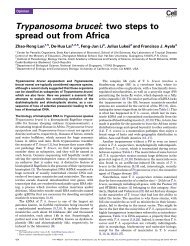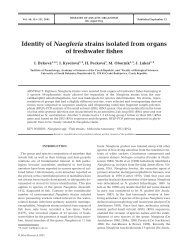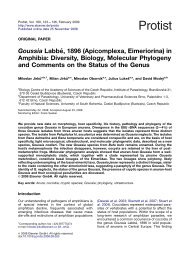Translational initiation in Leishmania tarentolae and Phytomonas ...
Translational initiation in Leishmania tarentolae and Phytomonas ...
Translational initiation in Leishmania tarentolae and Phytomonas ...
Create successful ePaper yourself
Turn your PDF publications into a flip-book with our unique Google optimized e-Paper software.
6 J. Lukeˇs et al. / Molecular & Biochemical Parasitology xxx (2006) xxx–xxx<br />
observed (Fig. 2B). A comparison between the subset of 37 pre-<br />
ATG triplets <strong>in</strong> P. serpens <strong>and</strong> L. <strong>tarentolae</strong> showed that <strong>in</strong> 80%<br />
of cases, the triplets behave similarly <strong>in</strong> both species. Yet, significant<br />
differences were observed <strong>in</strong> several cases (<strong>in</strong> particular<br />
triplets AUG, GCA <strong>and</strong> GGC (Fig. 2)).<br />
Taken together, these data have the follow<strong>in</strong>g implications.<br />
First, the orthologous SSU rDNA-target<strong>in</strong>g region is sufficient<br />
for homologous recomb<strong>in</strong>ation <strong>in</strong> P. serpens. Second, the UTRs<br />
flank<strong>in</strong>g the EGFP gene, derived from the L. <strong>tarentolae</strong> calmodul<strong>in</strong><br />
(cam) operon gene cluster [21] are able to direct efficient<br />
trans-splic<strong>in</strong>g, RNA process<strong>in</strong>g <strong>and</strong> translation <strong>in</strong> P. serpens.<br />
Typically, <strong>in</strong> trypanosomatids high-level prote<strong>in</strong> expression<br />
requires the presence of homologous UTRs [34], <strong>in</strong>dicat<strong>in</strong>g that<br />
the UTRs of the cam genes of L. <strong>tarentolae</strong> conta<strong>in</strong> RNA stabiliz<strong>in</strong>g<br />
sequences conserved <strong>in</strong> trypanosomatids. This assumption<br />
is supported by the f<strong>in</strong>d<strong>in</strong>g that the pF4X1.4 expression vectors<br />
mediated efficient expression also <strong>in</strong> other <strong>Leishmania</strong> species,<br />
such as L. major, L. mexicana, L. donovani <strong>and</strong> L. <strong>in</strong>fantum<br />
(Goyard S., personal communication).<br />
3.3. The pre-ATG triplet strongly <strong>in</strong>fluences the expression<br />
of TET-R <strong>and</strong> dsRED, but the <strong>in</strong>fluence is gene-dependent<br />
Hav<strong>in</strong>g demonstrated that the pre-ATG triplet strongly <strong>in</strong>fluences<br />
the efficiency of EGFP mRNA translational <strong><strong>in</strong>itiation</strong> <strong>in</strong><br />
L. <strong>tarentolae</strong> <strong>and</strong> P. serpens, we thought to analyze whether<br />
the observed effect would also occur with other prote<strong>in</strong> cod<strong>in</strong>g<br />
genes. We chose as reporter the tetracycl<strong>in</strong>e repressor TET-R<br />
[35] <strong>and</strong> the red fluorescent prote<strong>in</strong> dsRED [36] <strong>and</strong> as host L.<br />
<strong>tarentolae</strong>. To m<strong>in</strong>imize the potential <strong>in</strong>fluence of the 5 ′ end<br />
sequence of the open read<strong>in</strong>g frame, <strong>in</strong> the constructs conta<strong>in</strong><strong>in</strong>g<br />
the dsRED gene the codons for the first three am<strong>in</strong>o acids of<br />
EGFP have been reta<strong>in</strong>ed.<br />
Based on the EGFP dataset, AUC <strong>and</strong> ACC were selected as<br />
the “strong” triplets, <strong>and</strong> UCG <strong>and</strong> CCA as the “weak” ones.<br />
The recomb<strong>in</strong>ant L. <strong>tarentolae</strong> cell l<strong>in</strong>es were constructed as<br />
described <strong>in</strong> Section 2 <strong>and</strong> prote<strong>in</strong> expression levels were analyzed<br />
by fluorescence measurements (dsRED) or by quantitative<br />
Western blott<strong>in</strong>g (TET-R). The results <strong>in</strong>dicate that the expression<br />
levels of the selected pre-ATG variants vary among the<br />
constructs for both target genes, but correlate neither with the<br />
observed EGFP expression levels for the <strong>in</strong>dividual pre-ATG<br />
variants nor among themselves (Fig. 3). This observation suggests<br />
that although the pre-ATG triplet can strongly <strong>in</strong>fluence<br />
translational <strong><strong>in</strong>itiation</strong> <strong>in</strong> trypanosomatids, it appears to function<br />
<strong>in</strong> concert with a much larger portion of the cod<strong>in</strong>g part<br />
of mRNA. S<strong>in</strong>ce there is no record of translational <strong><strong>in</strong>itiation</strong> <strong>in</strong><br />
eukaryotes be<strong>in</strong>g <strong>in</strong>fluenced by AUG flank<strong>in</strong>g sequences beyond<br />
−4 [6], the observed <strong>in</strong>fluence is likely to be a result of secondary<br />
structure formation around start<strong>in</strong>g AUG. It has been shown<br />
recently that translation can be effectively blocked by the <strong>in</strong>troduction<br />
of a hairp<strong>in</strong> <strong>in</strong>to the 5 ′ UTR of trypanosome mRNAs<br />
[37]. Interest<strong>in</strong>gly, the region exert<strong>in</strong>g such an <strong>in</strong>fluence must<br />
also <strong>in</strong>volve a sizable portion of the cod<strong>in</strong>g region, certa<strong>in</strong>ly<br />
more than six nucleotides downstream of the start codon, thus<br />
coupl<strong>in</strong>g the <strong>in</strong>fluence of prote<strong>in</strong> sequence <strong>and</strong> codon usage on<br />
expression levels.<br />
Fig. 3. Levels of dsRED <strong>and</strong> TET-R prote<strong>in</strong>s vary <strong>in</strong> dependence on pre-ATG,<br />
as shown <strong>in</strong> wild type <strong>and</strong> four transfected L. <strong>tarentolae</strong> cell l<strong>in</strong>es. The pre-ATG<br />
triplet used for transfection is shown below the lanes. (A) Expression levels of<br />
dsRED are shown <strong>in</strong> relative fluorescence units. (B) Expression levels of TET-R<br />
are shown <strong>in</strong> arbitrary units as relative density of specific b<strong>and</strong>s.<br />
The identification of pre-ATG triplets capable of prote<strong>in</strong><br />
expression modulation potentially provides a tool for eng<strong>in</strong>eer<strong>in</strong>g<br />
k<strong>in</strong>etoplastid flagellates, where the paucity of identified<br />
tunable promoters significantly limits the scope of expression<br />
constructs. An alternative is tun<strong>in</strong>g the levels of prote<strong>in</strong> expression<br />
by eng<strong>in</strong>eer<strong>in</strong>g the 5 ′ <strong>and</strong> 3 ′ UTRs, which is highly empirical<br />
[34]. Possible alternatives also <strong>in</strong>clude manipulation of transsplic<strong>in</strong>g<br />
<strong>and</strong> polyadenylation efficiencies that so far have not<br />
been put to practical purposes. Admittedly, the presented alternative<br />
requires construction <strong>and</strong> analysis of pre-ATG variants<br />
for each <strong>in</strong>dividual prote<strong>in</strong>, a laborious proposition when the<br />
entire range of expression levels is desired. However, it may be<br />
of importance when one attempts to overexpress a heterologous<br />
gene to high levels s<strong>in</strong>ce, as was shown for EGFP <strong>and</strong> dsRED,<br />
some pre-ATG triplets may lead to a total lack of expression<br />
(Fig. 3). In pr<strong>in</strong>ciple, this could be avoided by <strong>in</strong> silico analysis<br />
of mRNA structures. However, our <strong>in</strong>itial efforts to correlate the








